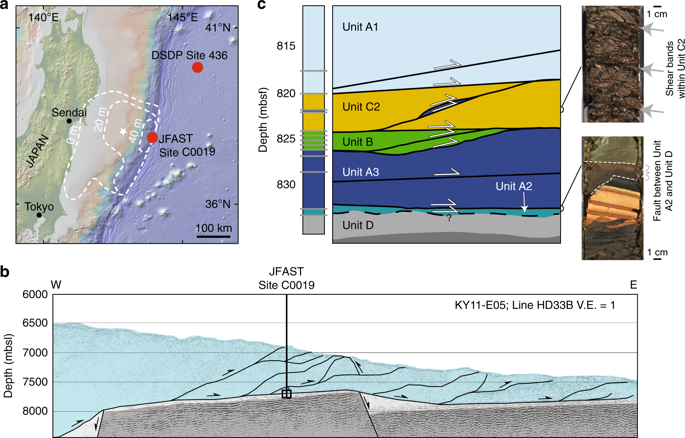当前位置:
X-MOL 学术
›
Nat. Commun.
›
论文详情
Our official English website, www.x-mol.net, welcomes your
feedback! (Note: you will need to create a separate account there.)
Earthquake slip surfaces identified by biomarker thermal maturity within the 2011 Tohoku-Oki earthquake fault zone.
Nature Communications ( IF 14.7 ) Pub Date : 2020-01-27 , DOI: 10.1038/s41467-020-14447-1 Hannah S Rabinowitz 1 , Heather M Savage 2 , Pratigya J Polissar 3 , Christie D Rowe 4 , James D Kirkpatrick 4
Nature Communications ( IF 14.7 ) Pub Date : 2020-01-27 , DOI: 10.1038/s41467-020-14447-1 Hannah S Rabinowitz 1 , Heather M Savage 2 , Pratigya J Polissar 3 , Christie D Rowe 4 , James D Kirkpatrick 4
Affiliation

|
Extreme slip at shallow depths on subduction zone faults is a primary contributor to tsunami generation by earthquakes. Improving earthquake and tsunami risk assessment requires understanding the material and structural conditions that favor earthquake propagation to the trench. We use new biomarker thermal maturity indicators to identify seismic faults in drill core recovered from the Japan Trench subduction zone, which hosted 50 m of shallow slip during the Mw9.1 2011 Tohoku-Oki earthquake. Our results show that multiple faults have hosted earthquakes with displacement ≥ 10 m, and each could have hosted many great earthquakes, illustrating an extensive history of great earthquake seismicity that caused large shallow slip. We find that lithologic contrasts in frictional properties do not necessarily determine the likelihood of large shallow slip or seismic hazard.
中文翻译:

通过生物标志物热成熟度确定的2011年东北冲木地震断裂带内的地震滑动面。
俯冲带断层浅深度的极端滑移是地震造成海啸的主要原因。改善地震和海啸风险评估需要了解有利于地震传播到海沟的材料和结构条件。我们使用新的生物标志物热成熟度指标来识别从日本海沟俯冲带中回收的钻芯中的地震断层,日本海沟俯冲带在2011年Mw9.1东北大地震中托管了50 m的浅层滑动。我们的结果表明,多处断层曾孕育位移≥10 m的地震,每处都可能孕育了许多大地震,这说明了造成大的浅层滑移的大地震地震活动的广泛历史。
更新日期:2020-01-27
中文翻译:

通过生物标志物热成熟度确定的2011年东北冲木地震断裂带内的地震滑动面。
俯冲带断层浅深度的极端滑移是地震造成海啸的主要原因。改善地震和海啸风险评估需要了解有利于地震传播到海沟的材料和结构条件。我们使用新的生物标志物热成熟度指标来识别从日本海沟俯冲带中回收的钻芯中的地震断层,日本海沟俯冲带在2011年Mw9.1东北大地震中托管了50 m的浅层滑动。我们的结果表明,多处断层曾孕育位移≥10 m的地震,每处都可能孕育了许多大地震,这说明了造成大的浅层滑移的大地震地震活动的广泛历史。











































 京公网安备 11010802027423号
京公网安备 11010802027423号